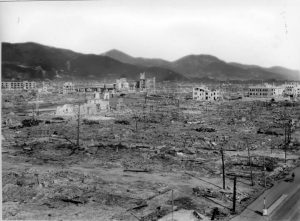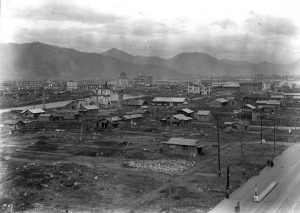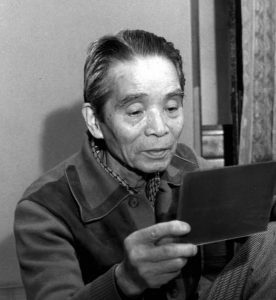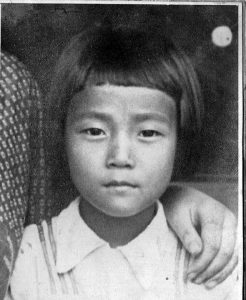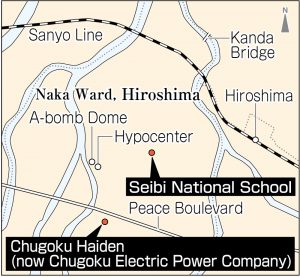Striving to fill voids in Hiroshima, evidence of victims remains 76 years after atomic bombing—Photos of A-bombing destruction, Part 4: Scenes from head office of present-day Chugoku Electric Power captured by Yoshita Kishimoto
Dec. 8, 2021
Considered fixed-point observation photos of city’s recovery to be “obligation”
Eight years spent observing city where daughter died
by Junji Akechi, Staff Writer
One photograph shows Hiroshima dotted with concrete buildings that somehow escaped destruction as well as burned and fallen houses and trees. In the center of the photo is a small image of the Hiroshima Prefectural Industrial Promotion Hall, later to be named the Atomic Bomb Dome. The photo was taken between October and November 1945 by Yoshita Kishimoto, who died in 1989 at the age of 87.
The photo is among those taken by Mr. Kishimoto as part of a project requested by Chugoku Haiden (now the Chugoku Electric Power Company, located in Hiroshima’s Naka Ward). Mr. Kishimoto took a series of photos in four directions from the rooftop of the company’s head office. He continued to take photos from the same location until 1953. The photo series represents fixed-point, stationary observations of the city’s recovery from the disaster.
Mr. Kishimoto was 43 at the time of the atomic bombing and had a photo studio in the Tanaka-machi area (now part of Naka Ward). When the atomic bomb was dropped, he was at home with his wife Shizuko, then 35, in the Ushita-cho area (now part of the city’s Higashi Ward). The couple’s daughter Sumie, eight years old at the time, was a second-grader at what was known as Seibi National School, in present-day Naka Ward. She went to school looking forward to the school lunch of pumpkin squash.
Taking up photography once again
According to notes from the time and records left by family members, the couple searched far and wide for their daughter, who had not returned home. Shizuko discovered Sumie near the Kanda Bridge, not far from their home. Sumie was apparently heading home after suffering burns over her entire body. “Mom, you were too late,” she reportedly said and breathed her last as she was being carried to a shelter.
“Because my daughter died, I didn’t feel like touching a camera after the atomic bombing. Only after I received a request from Chugoku Haiden to do a survey could I once again start taking photos” (as reported in The Chugoku Shimbun, 1981). Mr. Kishimoto began taking photos again in the fall of 1945, carefully recording damage to power plants, utility poles, and power distribution equipment.
At that time, he came up with the idea that he should keep a record of the city’s recovery by taking photos from a fixed location. “I should keep a record of Hiroshima’s tragedy. This is my obligation as a citizen that survived” (as recounted in the Record of the Hiroshima A-bomb Disaster, published in 1971).
Involved in photo preservation
Mr. Kishimoto continued to operate a photography studio after the war. In 1978, he joined a group of photographers called the Association of Photographers of the Atomic Bomb Destruction of Hiroshima. He began to be actively involved in the preservation of photographs of the atomic bombing. He also shared his experience in the atomic bombing at schools and held photo exhibits.
His family, however, sensed that Mr. Kishimoto suffered deep wounds that would not heal. His son, Hiroshi, who died in 2020 at age 85, and Hiroshi’s wife, Mizuyo, now 82, had a baby girl in 1963. Mizuyo said her parents-in-law truly loved the girl, often exclaiming, “She looks just like Sumie.” They would take the girl to their home next door and have her stay overnight. They also bought her custom-made clothes and took photos of her, which they would display at the photo studio. “I was one year behind Sumie, and my parents-in-law were very kind to me,” said Mizuyo. She thought about the heartache of her late father-in-law, whose demeanor was consistently calm and who never spoke of his experience in the atomic bombing at home.
In 2008, an album containing 54 original photos taken by Mr. Kishimoto for a damage survey as well as fixed-point observations of the city’s recovery was donated to the Hiroshima Peace Memorial Museum, located in the city’s Naka Ward. The album was found at the home of a person involved with Chugoku Haiden. At Mr. Kishimoto’s home, some 200 items such as dry glass plates were also found. The museum has been making efforts to preserve and utilize the items through digitization and other means.
Mr. Kishimoto continued to take photos from a fixed location for eight years after the atomic bombing. This reporter had the chance to look carefully again at the changes Hiroshima went through following the war.
Grass began to grow in areas that had been scorched by flames. Shacks appeared here and there, and the area grew crowded with many such structures. Reorganization of city lots began in preparation for construction of Peace Boulevard. Mr. Kishimoto calmly took photos of the continually changing lives of people even after the atomic bombing. The visual record was logged by the photographer, who lived in a Hiroshima in which his daughter was absent.
(Originally published on December 8, 2021)

